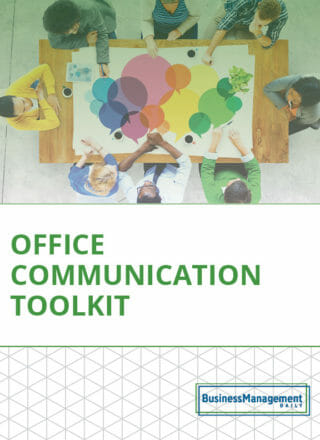Business communication skills that every professional needs

Essential communication skills for the workplace
Communication is the foundation of every business activity and most of our daily activities. However, communicating in a business setting can be slightly different and often more stressful than our everyday communications.
Whether you’re talking to a customer, manager, or coworker, you want to make the right impression. Here are the skills and best practices you need to adopt in order to navigate communication in a work environment.
Tailoring business communication to company culture
Just like you adjust your clothing for different business settings, you’ll need to learn to adjust your communication. For example, if you work in a more formal setting, you’d wear a suit rather than jeans. Your tone and communication style should also be adjusted to match the desired level of formality.
If you are new to your organization, note how other members of your workplace greet one another. It may vary depending on each member’s place in the org chart.
Do your coworkers greet your manager with a “Good Morning, Sir” or a “Hey, What’s Up?”. Do team members share memes or GIFs in the team Slack channel, or is it for more focused and formal business discussions?
Effective business communication can be tricky; what is normalized or acceptable will vary between different businesses. However, listening and observing are key parts of effective communication, so use those skills to gain an understanding of each business’ culture and norms.
Communication skills for effective teamwork
Being a good collaborator and team member goes a long way in business. Employers like to see that you can communicate and collaborate effectively with your peers.
Conflict resolution
Often, conflicts or disagreements arise simply due to poor communication. Building a diverse workplace also means that you’re likely to experience differences of opinion, as everyone is coming to the table with different experiences, cultures, and ideas. This is a good thing!
Conflict is often healthy in the business world. Healthy and respectful conflict leads to better decision-making and greater innovation.
Emotional intelligence is necessary for good communication and conflict resolution in the workplace. Specifically, emotional intelligence is the ability to recognize and control one’s own emotions.
Additionally, it includes perceiving and understanding other people’s emotions. Professionals, therefore, need self-awareness. They must recognize when emotions distort their view and when a discussion becomes too passionate. Moreover, it’s important to recognize team members’ feelings.
It is also important to acknowledge those feelings. If you have upset someone, engage in respectful conflict resolution. Similarly, engage in respectful conflict resolution if a misunderstanding has occurred. Finally, emotionally intelligent professionals proceed calmly and with empathy when conflict arises.
Active listening skills
Be honest with yourself. When others in the workplace are talking, are you really listening to them, or do you find yourself getting distracted or thinking about what you are going to say next?
When you are nervous in business settings, it is easy to focus on what you need to say, your own body language, and how you are being perceived.
However, you’ll likely make a better impression by being a good listener and engaging with others when they speak rather than focusing solely on your half of the interaction.
Leverage your nonverbal communication skills to demonstrate that you are listening by having open body language (avoid crossing your arms), maintaining eye contact with the speaker, and nodding or making appropriate gestures in response to what the speaker is sharing. Use facial expressions and nonverbal cues to show that you’re engaged.
You may also speak at appropriate points to agree with the speaker, clarify something they’ve said, or provide appropriate commentary. Try not to provide commentary that changes the direction of the conversation or brings the focus back to you too heavily.
Often, we try to share examples of our own experiences or stories to relate to others, but it’s helpful to let the person finish what they were sharing first. You don’t want to become the coworker that makes every conversation about yourself.
Business writing skills
A common mistake people make when writing in a business setting is trying too hard to sound smart. Business writing should be formal but also clear.
Don’t use abbreviations or any of the silly phrases that you’d use on social media. However, you don’t want to turn every memo or email into a PhD thesis.
The best-written communication skill is the ability to convey a message clearly and concisely. Craft messages that give the intended audience exactly the information they need to know. Avoid uncertainty or excessive wordiness. After all, most business professionals are busy.
Being able to adjust your tone in writing can be a bit trickier than in speech. Practice writing in a motivational tone (commonly used for LinkedIn posts in case you need a reference point), serious or formal tones (for writing related to HR, policy, or legal topics in business), and friendly tones (to use with leads and coworkers).
Presentation skills
Were you one of those kids who hated speaking in front of the class? Well, then, it’s time to improve your presentation skills.
Not all careers require frequent presentations, but it’s rare to find a role where you never need to speak or share information with the group in a meeting. Public speaking can be scary, but there are a couple of tools that you can use to improve:
-
Be mindful of pacing. Often when people are nervous, they speak too quickly. This makes it hard for your audience to understand what you are saying. Practice reciting information or a presentation at a steady pace with a medium tempo.
-
Learn how to connect with your audience. If you are giving a presentation at work, choose a coworker with whom you feel comfortable and look at them as you present. You may even want to ask them to sit front and center. Looking out into the audience helps you appear more confident and better engages your audience.
-
Build confidence. Public speaking is largely about confidence—or at least sounding confident. If you must give a presentation at a staff or client meeting, ask a few coworkers to listen to you practice. Starting with a smaller audience can help.
If you are working on general public speaking skills and don’t have a presentation coming up, build confidence by concentrating on speaking up more during meetings. Many of us spend most meetings on mute or sitting quietly in the back of the room. Gradually increase your participation by speaking up and getting comfortable sharing ideas publicly.
Consider your communication channel
One of the most common business communication mistakes is choosing the wrong communication channel for their message. Everyone hates attending a meeting that could have been an email, right? However, the inverse can also be true.
Never be afraid to ask someone about their preferred communication methods. Knowing your audience is important. For example, if you need to follow up with a customer, ask them how they would like you to follow up during the initial conversation.
Some people like the personal touch of a phone call, while other customers may be too busy to answer unscheduled calls or feel more comfortable with email or text messaging.
While communication channel preferences are often associated with generational differences, asking rather than assuming what a customer will prefer is a good idea. Learning how to communicate with customers based on their preferences will allow you to provide better customer service.
Matching message to medium
You can also apply this to coworkers and managers. Instant messaging is becoming a popular form of communication between workplace teams, so you may be directed to use Teams or Slack for day-to-day conversations and teamwork. When you start a new job, ask about the best channel for questions to coworkers and your manager’s preferences.
In addition to asking about individual preferences, it’s essential to understand what messages are well-suited for written communication and which should be delivered in person (or at least over Zoom).
Think about whether the recipient is likely to have questions about what you are telling them or if the message could raise concern when delivered in writing.
After all, some messages may feel more ominous when nonverbal communication, such as tone and body language, is absent.
If communicating major changes, face-to-face may be best so that you can answer questions immediately and ensure your message is delivered in the correct tone.
Strong communication comes from practice
Don’t worry if you haven’t mastered all the skills on the list. Many coworkers are still intimidated by speaking up during large meetings or handling conflict. The best way to improve is to practice.
Use LinkedIn to practice your professional writing skills and break out of your comfort zone. Work up to public speaking by actively participating in smaller meetings.
Observe your company’s culture and practice active listening to understand how others communicate within your organization. Building communication skills is an ongoing process.
More resources:
Business communication skills that every professional needs
The top 7 business writing skills you should master
Understanding new-collar jobs: A path to success without a degree
Want more insights like these? Visit Kaylyn McKenna’s author page to explore her other articles and expertise in business management.




